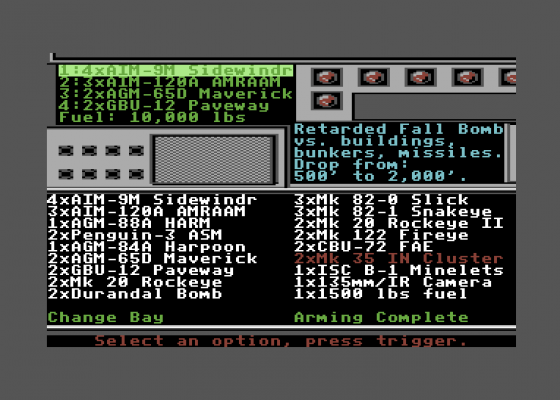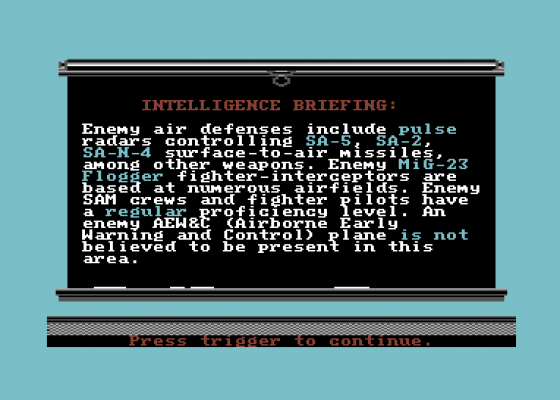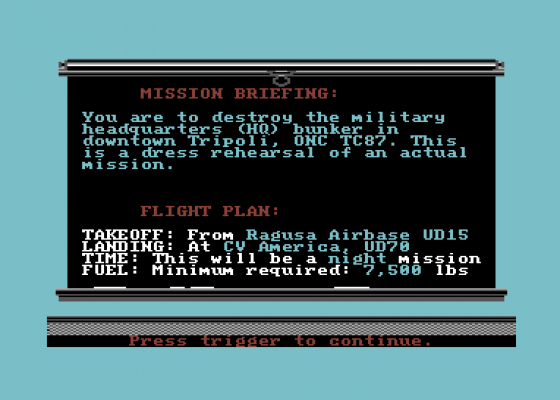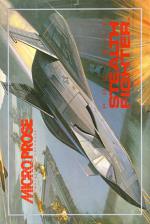
Zzap
 1st March 1988
1st March 1988
Microprose's state-of-the-art jet combat simulator
Project Stealth Fighter
Grasp the yoke of the top secret Lockheed F-19 Stealth Fighter and run the gauntlet of hostile missile batteries, ships and aircraft over the possible war-zones of Libya, the Persian Gulf, the North Cape of Finland, and Central Europe.
Prior to taking off, the budding pilot is able to set the simulation parameters via a series of option screens. The player first enters his name to create a new pilot, or retrieves a previously saved one from disk. A geographical setting is then selected, plus the option to fly the Libyan mission with zero risk from enemy fire, allowing a new pilot to practise flight and combat.
Further options include: level of conflict (cold war to conventional war), type of target (airborne, tactical or strategic), enemy skill level and level of realism (with respect to landing and enemy hits). All choices have some bearing on the overall difficulty, which is constantly displayed at the bottom of the menu screens.

After an intelligence briefing, the F-19 is armed for the mission chosen. The action then shifts to the jet itself, with the screen displaying a wire-frame perspective view of the locality, with the Stealth's instrument panel beneath. All the gauges and instruments associated with flight are present, but the most important information - notably air-speed, heading and altitude - are displayed on a Head Up Display (HUD) projected onto a transparent plate inside the front of the canopy. This allows the pilot to keep an eye on the action and target bombs, missiles and cannon without having to look away to check his flight statistics.
On the instrument panel there are three main CRT displays. A colour CRT toggles between an area map of the whole war-zone, which indicates objectives and current position, and a more localised tactical map showing ground installations. A monochrome CRT informs the pilot of such information as damage status, hostile identity, radio messages and weapons data. In the centre of the panel is a variable scale Threat Display which shows surrounding RADAR and heat sources. The display can be toggled between surface and airborne target detection and relays the positions of aircraft and SAM sites so that evasive or offensive action can be taken.
Another vital display is the Electromagnetic Visibility (EMV) LED bar graph. This shows how visible the Stealth fighter appears to any hostile scanning by monitoring its current electromagnetic emissions. The F-19 has been designed to give the lowest RADAR profile possible, but flying with the weapon bays open, for example, increases its visibility.

Points are scored for the destruction of enemy targets, including SAM sites and jet interceptors, as well as the primary objectives. The F-19 has four weapon bays which each carry a different set of rockets or bombs. Whenever a weapons bay is opened, a free-floating sight appears on the HUD as possible targets come into view. With missiles activated, the targetting computer draws a box around the foe, which is then identified and ranged. As the F-19 closes in, the targetting computer attempts to lock the missile onto the enemy craft, altering the colour of the sight when it has done so. This is the optimum moment for a successful shot, since the computer can lose the target if it moves out of range.
Bombing ground installations is achieved in a similar fashion. Laser-guided bombs are targetted like missiles, but free-fall or retarded-fall bombs are aimed manually using a projected drop sight on the HUD screen. When the sight coincides with the target box containing the installation, the bombs are released - hopefully with destructive results.
The F-19 is equipped with three defensive systems which deter any hostile attacks. These are an Electronic Counter-Measures system which confuses radar-guided missiles, an Infra-Red jammer to evade heat-seeking missiles, and a limited supply of multi-purpose decoys which are used should the two jammers be destroyed.

A mission ends when either the Stealth Fighter is destroyed or it successfully lands behind Allied lines. Ejecting lets the pilot live to fight another day, but can create an embarrassing international incident, and does little to earn him the respect of the boys in the Officer's Club.
After the flight, the pilot is given a mission score and a stealth rating dependent upon how well the stealth technology was used. Good combat performance may be rewarded with a medal, and constant success results in promotion from Second Lieutenant through the ranks up to Brigadier General.
I certainly hope you don't intend saving any money this month - not with Project Stealth Fighter around, anyway! Microprose's latest simulation follows closely in the vapour trail of Gunship, but still manages to improve upon the gameplay and graphics, providing a tense and atmospheric stage on which to act our your airborne ambitions.

The presentation is of the same high standard, with all the trappings of its predecessor and enough technical documentation to keep any statistic freak happy. The wealth of missions and opportunities of play should make it a lasting investment, and indeed the only reservation I have is that some Gunship pilots may find Project Stealth Fighter's style of action a little too similar to its predecessor.
Personally, I feel the mode of flying is sufficiently different, and there's more in the way of playability. Project Stealth Fighter is excellent, and sets new standards to which others must now aspire.
PG
What should I say first about Project Stealth Fighter? Should I tell you about the superlative quality of the graphics? The incredible playability, perhaps? No, I'll tell you about the incredible - or should I say very credible - atmosphere which the whole package exudes, because that's what makes this simulation something really special.

If you overlook the slightly sickening jingoism of some of the text, the manual makes excellent and enlightening reading. The sections on dogfight tactics are particularly interesting, because after some practice it's actually possible to make use of them in the game!
Something else which adds to the aura of realism is the topicality of the mission scenarios, which leave you half-expecting to hear about a failed Stealth mission over one of the world's current trouble-spots on the evening news. There's just so much depth and playability to this that any flight simulation fan with a disk drive and twenty quid to spare would be crazy not to buy it.
JR
I've been waiting for Project Stealth Fighter to arrive ever since I saw an early version at the PCW show in September - and the wait has been worth it. Microprose's latest is an action-packed combat simulator which boasts some fast, very realistic graphics and great playability.
There's an incredible amount of missions to tackle, ranging from training sessions, through minor cold war forays into enemy territory and reconnaissance missions to a conventional non-nuclear conflict - the sheer depth is incredible!
The comprehensive series of menus and intermission screens help draw the player into the action, and it's easy to become totally emboriled in the proceedings.
The concentration required to actually fly the Stealth and the feeling that you're really flying a mission only helps sustain the involvement. The packaging is tremendous, with a keyboard overlay, two maps, a technical supplement and a very thick manual - which is a very good read (if you can stand its paranoid "reds under the beds" tone).
All in all, Project Stealth Fighter is superb, and should keep prospective Stealth pilots happily flying for months.
Verdict
Presentation 98%
Superbly presented on-screen and off, with well-structured disk access and some great packaging and documentation.
Graphics 92%
Convincing landscapes and combat representation, and clear instrument panel graphics.
Sound 51%
Effective engine and battle noises.
Hookability 90%
Considering the simulator's complexity, it's surprisingly easy to get into.
Lastability 93%
A wealth of missions, and plenty of room for enjoyable progression.
Overall 96%
An utterly praiseworthy combat simulator which ranks as one of the best.



